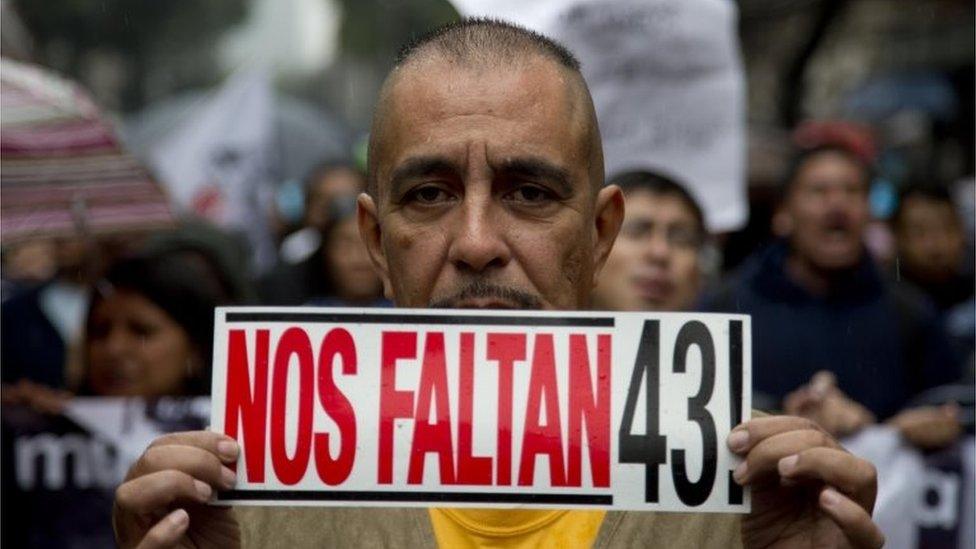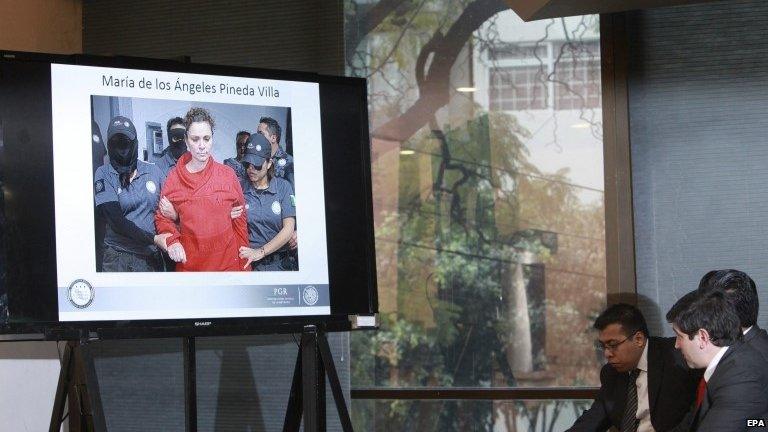Mexico federal police 'saw Iguala students being taken away'
- Published

Relatives of the students have disputed the government's account of what happened
Mexico's human rights commission says two Mexican federal police officers participated in the disappearance of 43 students in Guerrero state in 2014.
An unidentified witness said the federal officers were present when 15 to 20 youths were taken off a bus and led away, the commission said.
Local police told them they were taking the students away for "the boss" to decide their fate, the commission said.
The government says corrupt local police handed them to a drugs cartel.
The criminals then killed the students and incinerated their bodies, the government says.
Jose Larrieta Carrasco from the National Human Rights Commission (NHRC) said the witness overheard conversations by Iguala police who forced the bus to stop by shooting out its tyres.
When federal police arrived and asked what was happening, an Iguala officer reportedly said they were taking the students away to the town of Huitzuco for "the boss" to decide what to do with them.
The federal officers said "OK, that's good" and allowed the local police to take the students away, the NHRC said.
Mr Larrieta said the commission's findings were "clear evidence of the co-opting of municipal institutions by criminal organizations" in towns including Iguala and Huitzuco.
"In the same way it could be an example of the alleged involvement of federal police officers," he said.
Mr Larrieta also said that businesses had impeded the investigation by hiding evidence. He did not identify the companies or say whether they were the owners of the bus lines involved.
The NHRC urged the federal Attorney General's Office to find the identities of the two federal police who were at the scene.
It also said authorities should investigate the possibility that state officials were also present.
New probe
Relatives of the students have disputed the government's account of what happened in September 2014.
The investigation into the students' disappearance was reopened last October after international criticism.
An international panel of experts said the government's account that the students were burnt beyond identification at a rubbish dump was physically impossible.
It said official reports appeared to downplay the presence of federal police and troops near the areas where the students were seized.
The experts also said the army had refused to allow them to interview soldiers.

The missing 43 at a glance

Who are they?
The 43 were all students at an all-male teacher training college in the town of Aytozinapa, in south-western Guerrero state. The college has a history of left-wing activism and the students regularly took part in protests.
What happened to them?
They disappeared from the nearby town of Iguala on the evening of 26 September 2014 amid a confrontation between municipal police and the students during which six people were killed.
Have any of them been found?
Independent forensic experts have matched charred bone fragments reportedly found at a rubbish dump near Iguala to Alexander Mora, one of the 43 missing students. They also say there is a high probability another set of remains could belong to Jhosivani Guerrero de la Cruz, another of the students. However, experts from the Inter-American Commission of Human Rights say the chain of evidence was broken and they could not be sure the bone fragments had been found at the dump.
What is the government's version of events?
According to the official report, the students were seized by corrupt municipal police officers who handed them over to members of a local drugs gang. The drugs gang mistook the students for members of a rival gang, killed them and burned their bodies at the dump before throwing their ashes into a nearby stream.
Why do the families not believe the official report?
They think officials have failed to investigate the role soldiers from a nearby barracks may have played in the students' disappearance. The government has refused to let the soldiers, who were in the area at the time of the disappearance, be questioned by anyone but government prosecutors. The families also point to the report by the Inter-American Commission on Human Rights which said that there was no evidence the bodies of the 43 were burned at the dump.

- Published21 October 2015

- Published13 January 2015
